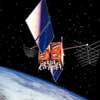|
Sunday:
March 23, 2003 | |
0115 GMT |
 |
Replacement Canadian satellite to ride Proton
The Canadian Anik F1R communications satellite -- a craft recently ordered to replace its namesake that suffered the effects of a design flaw in space -- will be launched aboard a Russian Proton rocket, officials have announced.
 FULL STORY FULL STORY
 |  |

|
 |
Next-generation satellite ordered for Malaysia
Binariang Satellite Systems has bought a high-power commercial communications spacecraft from Boeing. The new Boeing 601HP satellite, designated MEASAT-3, will join two other craft in orbit for the Malaysia-East Asia Satellite network.
 FULL STORY FULL STORY
 |  |

|
 |
Space Command cancels Guardian Challenge
Air Force Space Command officials have canceled this year's Guardian Challenge, the annual space warfighter competition held at Vandenberg Air Force Base, California, because the command needs its resources focused on day-to-day operations.
 FULL STORY FULL STORY
 |  |

|
 |
|
Saturday:
March 22, 2003 | |
0442 GMT |
 |
NASA's Columbia mishap team reorganized
NASA has announced a revamped management team to oversee the agency's internal investigation of the Columbia disaster in accordance with a request made late last month by the independent Columbia Accident Investigation Board.
 FULL STORY FULL STORY
 |  |

|
 |
NASA to build a five-satellite research mission
A swarm of spacecraft, designed to fly through the space storms that cause aurora, has been chosen as the next mission in NASA's Medium-class Explorer program. The Time History of Events and Macroscale Interactions during Substorms (THEMIS) mission is scheduled to be launched in 2007.
 FULL STORY FULL STORY
 |  |

|
 |
|
Friday:
March 21, 2003 | |
0502 GMT |
 |
Weighing a black hole at the edge of the universe
For the first time, astronomers have weighed a black hole at the furthest reaches of the universe. A team of astronomers from Canada and the United Kingdom studied infrared light from the most distant quasar known, and found that the quasar contains a black hole one quadrillion times as massive as the Earth.
 FULL STORY FULL STORY
 |  |

|
 |
Artemis satellite relays first images for Envisat
The first satellite-relayed images from Envisat have been received, via the Artemis data-relay spacecraft in geostationary orbit. The images represent twin triumphs for the European Space Agency.
 FULL STORY FULL STORY
 |  |

|
 |
|
Thursday:
March 20, 2003 | |
0320 GMT |
 |
Data recorder recovered; could hold key insights
Search crews walking a grid near Hemphill, Texas, have found the shuttle Columbia's orbiter experiments recorder, or OEX, a tape recorder that stored key data about the shuttle's performance during re-entry.
 FULL STORY FULL STORY
 |  |

|
 |
Race to gamma ray burst reveals gigantic explosion
Scientists arriving on the scene of a gamma ray burst, just moments after the explosion, have witnessed the death of a gigantic star and the birth of something monstrous in its place, quite possibly a brand-new, spinning black hole.
 FULL STORY FULL STORY
 |  |

|
 |
|
Wednesday:
March 19, 2003 | |
1215 GMT |
 |
Hearing shows work to piece together known data
As investigators increasingly focus on a breach at or just behind the leading edge of the shuttle Columbia's left wing as the root cause of the Feb. 1 disaster, engineers poring over telemetry from the doomed ship are zeroing in on exactly where the breach must have occurred - and how it must have propagated - to explain the orbiter's response to the resulting aerodynamic forces that ultimately ripped the ship apart.
 FULL STORY FULL STORY
 |  |

|
 |
U.S. military officials talk space dominance
Anybody who goes against the massive space capability of the U.S. military "is in for a tough go," Air Force Maj. Gen. Franklin J. "Judd" Blaisdell told reporters during a recent Pentagon press briefing.
 FULL STORY FULL STORY
 |  |

|
 |
Assembly begins for NASA's Mercury space probe
Start the countdown clock at one year: the effort to assemble and test the MErcury Surface, Space ENvironment, GEochemistry, and Ranging (MESSENGER) spacecraft, set to embark next March on an historic voyage to the innermost planet, is well under way.
 FULL STORY FULL STORY
 |  |

|
 |
|
Tuesday:
March 18, 2003 | |
1400 GMT |
 |
Hearing focuses on debris, breakup mechanics
A NASA flight director told the Columbia Accident Investigation Board Monday he was amazed the doomed spacecraft was able to continue flying in relatively normal fashion for nearly 10 minutes while shedding multiple pieces of flaming debris as a plume of superheated air burned its way into the stricken ship's left wing.
 FULL STORY FULL STORY
 INVESTIGATION STATUS CENTER INVESTIGATION STATUS CENTER
 |  |

|
 |

Video coverage for subscribers only:
 VIDEO: THE BOARD HEARS FROM DR WILLIAM AILOR QT VIDEO: THE BOARD HEARS FROM DR WILLIAM AILOR QT
 VIDEO: USA'S DOUG WHITE & NASA'S PAUL HILL TESTIFY QT VIDEO: USA'S DOUG WHITE & NASA'S PAUL HILL TESTIFY QT
 SUBSCRIBE NOW SUBSCRIBE NOW

|
Pulsar bursts coming from beachball-sized structures
In a major breakthrough for understanding what one of them calls "the most exotic environment in the Universe," a team of astronomers has discovered that powerful radio bursts in pulsars are generated by structures as small as a beach ball.
 FULL STORY FULL STORY
 |  |

|
 |
Worried about asteroid-ocean impacts?
The idea that even small asteroids can create hazardous tsunamis may at last be pretty well washed up. Small asteroids do not make great ocean waves that will devastate coastal areas for miles inland, according to both a recently released 1968 U.S. Naval Research report on explosion-generated tsunamis and terrestrial evidence.
 FULL STORY FULL STORY
 |  |

|
 |
|
Monday:
March 17, 2003 | |
0122 GMT |
 |
Pushing back frontiers of Universe to era of first stars
Astronomers have used three of the most powerful telescopes in existence to identify some of the farthest galaxies yet seen. But at the same time, they have encountered a cosmic conundrum: it looks as if there were fewer galaxies forming stars at this early stage in the history of the Universe than in the more recent past.
 FULL STORY FULL STORY
 |  |

|
 |
Pinatubo eruption provides test of climate pattern
A recent NASA-funded study has linked the 1991 eruption of the Mount Pinatubo to a strengthening of a climate pattern called the Arctic Oscillation. For two years following the volcanic eruption, the Arctic Oscillation caused winter warming over land areas in the high and middle latitudes of the Northern Hemisphere, despite a cooling effect from volcanic particles that blocked sunlight.
 FULL STORY FULL STORY
 |  |

|
 |


 This exceptional chronicle of the historic Apollo 11 lunar landing mission features new digital transfers of film and television coverage unmatched by any other.
This exceptional chronicle of the historic Apollo 11 lunar landing mission features new digital transfers of film and television coverage unmatched by any other.